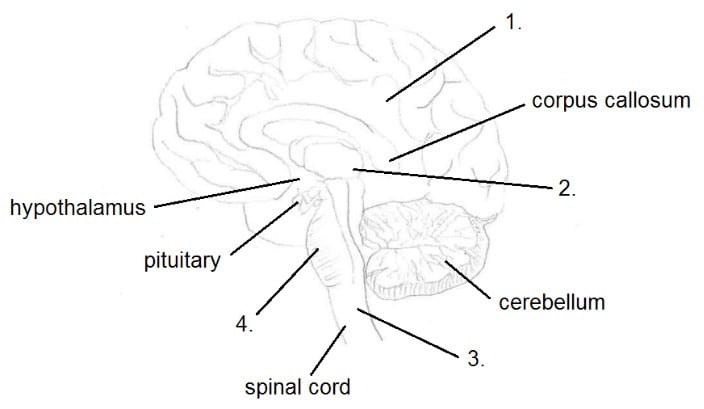TEAS-SECTION-2 Online Practice Questions and Answers
Which of the following is exchanged between two or more atoms that undergo ionic bonding?
A. electrical charges
B. valence electrons
C. transitory electrons
D. neutrons
Which of these make up a molecule of fat?
A. three molecules of fatty acid and one molecule of glycerol
B. one glycerol molecule and three stearic acid molecules
C. three molecules of glycerol and one molecule of fatty acid
D. one carbon, one hydrogen, and one oxygen molecule
Which of these statements regarding the process of fermentation is true?
A. It is an example of tissue respiration where yeast acts on carbohydrates to produce oxygen and alcohol.
B. It is an example of an aerobic process where yeast acts on a sugar solution to produce oxygen and alcohol.
C. It is an example of an anaerobic process where bacteria act on a protein solution to produce carbon dioxide and alcohol.
D. It is an example of an anaerobic process where yeast acts on a sugar solution to produce carbon dioxide and alcohol.
Which of these statements regarding the "oxygen debt" created during heavy exercise is true?
A. Oxygen debt is created due to build-up of acetic acid in the muscles, which needs a high level of oxygen to be oxidized.
B. Oxygen debt is created due to build-up of lactic acid in the muscles, which needs a high level of oxygen to be oxidized.
C. Oxygen debt is created due to build-up of lactic acid in the liver, which needs a high level of oxygen to be stored.
D. Oxygen debt is created due to build-up of lactic acid in the muscles, which needs a high level of carbon dioxide to be oxidized.
Ball and socket joints, pivot joints, plane joints, and hinge joints are which type of joints?
A. All of them are cartilaginous joints.
B. All of them are synovial joints.
C. Ball and socket and pivot joints are synovial joints. Plane and hinge joints are cartilaginous joints.
D. Ball and socket joints are synovial joints. The rest are fibrous joints.
Fill in the blank:
The hepatic portal vein carries __________, __________ blood from the __________ to the __________.
A. deoxygenated, nutrient-rich, intestines, liver
B. deoxygenated, nutrient-rich, liver, stomach
C. deoxygenated, nutrient-poor, liver, intestines
D. oxygenated, nutrient-rich, intestines, liver
Which of these is not a part of the central nervous system?
A. spinal cord
B. tract (bundle of nerve fibers/axons)
C. brain
D. cranial nerves
Which structure is not considered a part of the rib cage?
A. the thoracic vertebrae
B. costal cartilage
C. sternum
D. the lumbar vertebrae
Fill in the blanks:
Vitamin A, also known as __________, is a __________ vitamin. Its deficiency can lead to __________.
A. ascorbic acid, water-soluble, night blindness
B. calciferol, fat-soluble, osteoporosis
C. retinol, water-soluble, osteoporosis
D. retinol, fat-soluble, night blindness
Maturation and development of T cells takes place in which region?
A. spleen
B. bone marrow
C. lymph nodes
D. thymus gland
Which of these statements is true for boiling, but not true for evaporation?
A. Gas forms at the surface of the liquid.
B. The warmer the liquid is, the faster the process.
C. It takes place at a specific temperature.
D. The larger the surface area of liquid, the faster the process.
The law of conservation of mass states that __________.
A. The total mass of all products of a chemical reaction is independent of the total mass of all the reactants. They are not related.
B. The total mass of all products of a chemical reaction is equal to the total mass of all the reactants.
C. The total mass of all products of a chemical reaction is more than the total mass of all the reactants.
D. The total mass of all products of a chemical reaction is less than the total mass of all the reactants, because some mass coverts to energy during reaction.
What causes a moving body to resist a change in its state of motion?
A. its momentum
B. its speed
C. its acceleration
D. its inertia
Which of these organs is made up of epithelial tissue?
A. the skin
B. the liver
C. the heart
D. the brain

In this diagram of the brain, some of the labels are missing.
What should the labels be?
A. 1. cerebral cortex, 2. thalamus, 3. medulla oblongata, 4. pons
B. 1. cerebellum, 2. grey matter, 3. thalamus, 4. hindbrain
C. 1. forebrain, 2. midbrain, 3. brain stem, 4. pons
D. 1. hippocampus, 2. fornix, 3. midbrain, 4. pons
